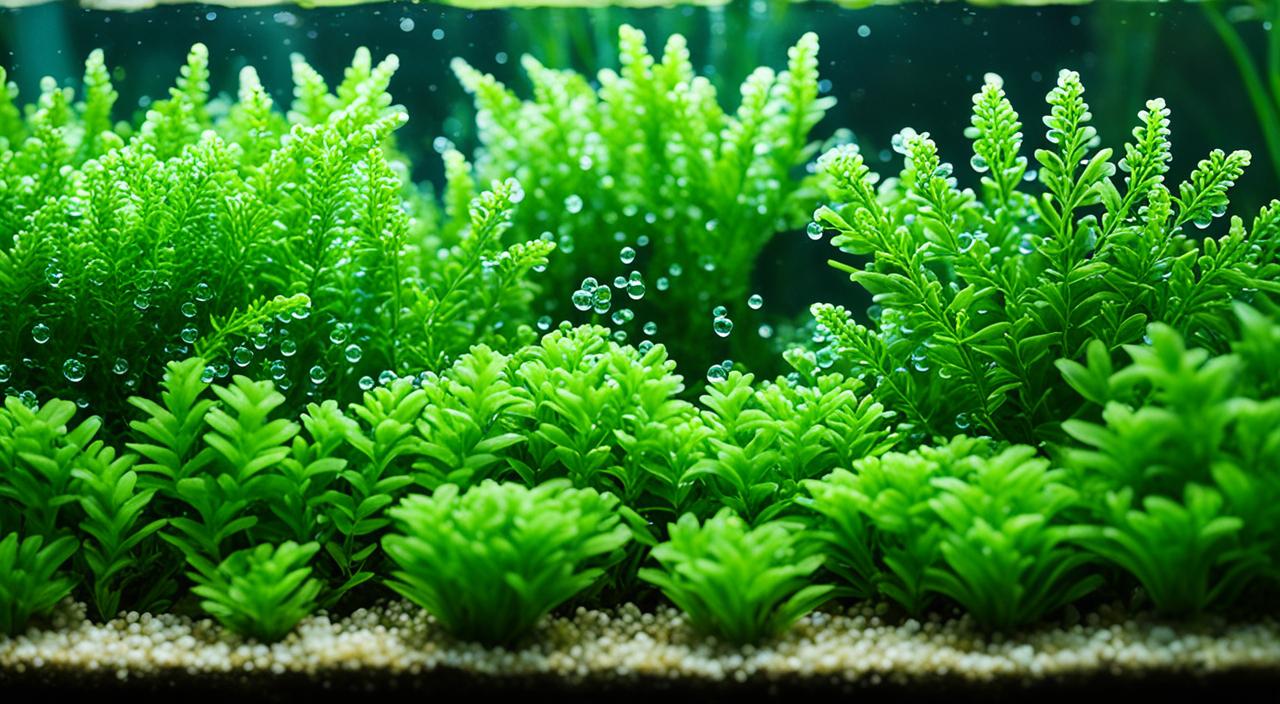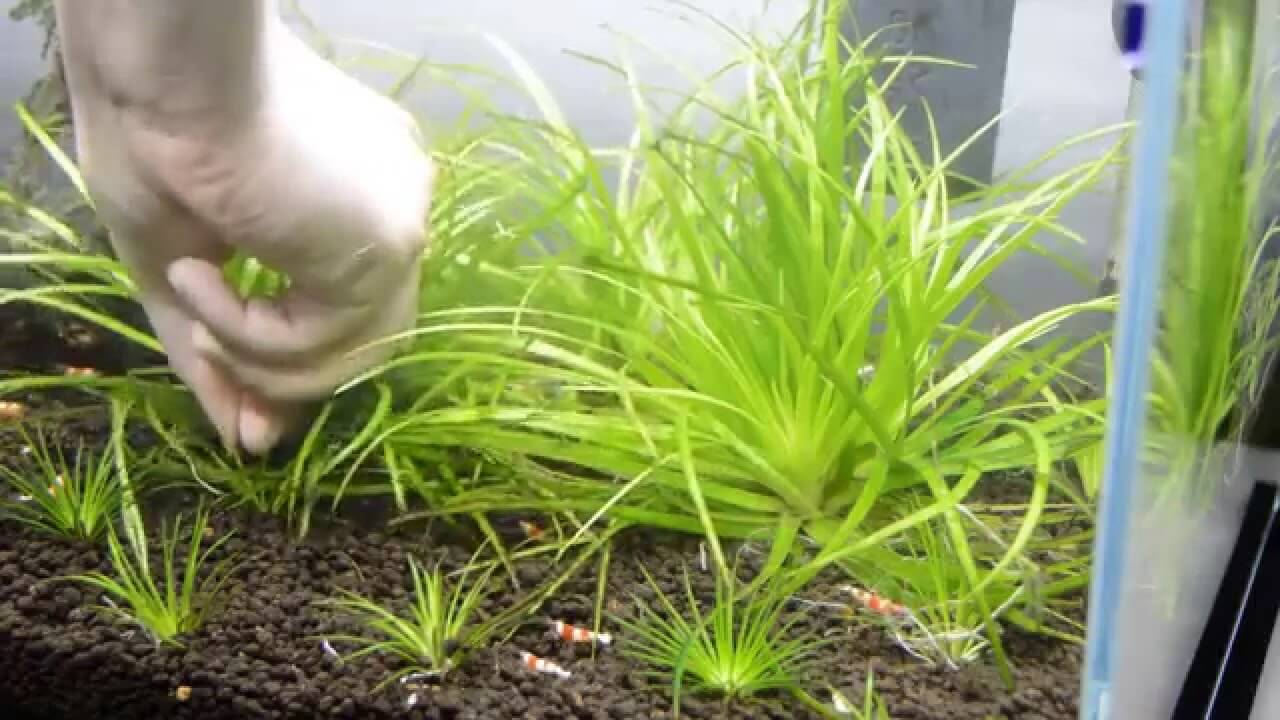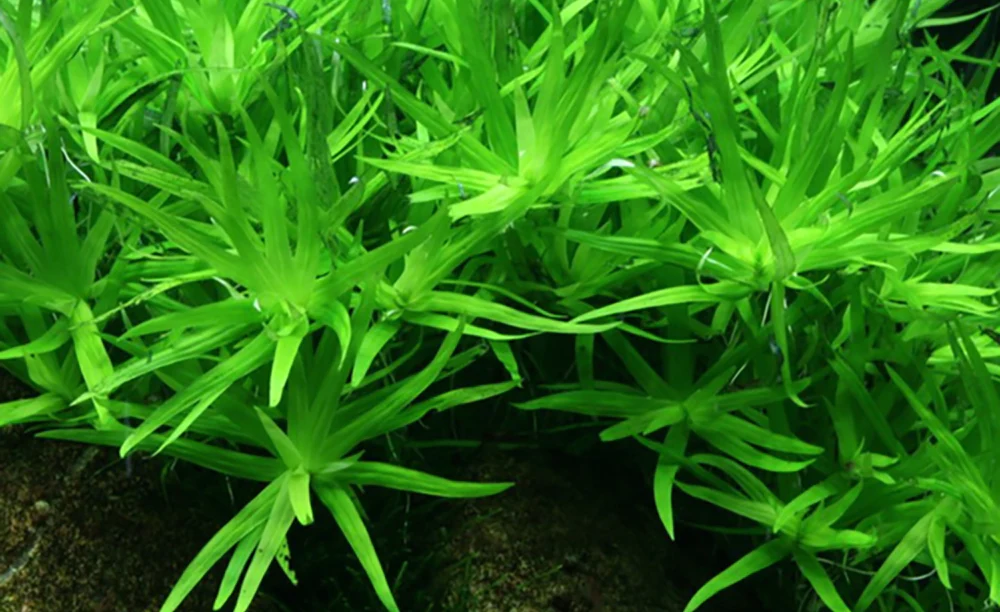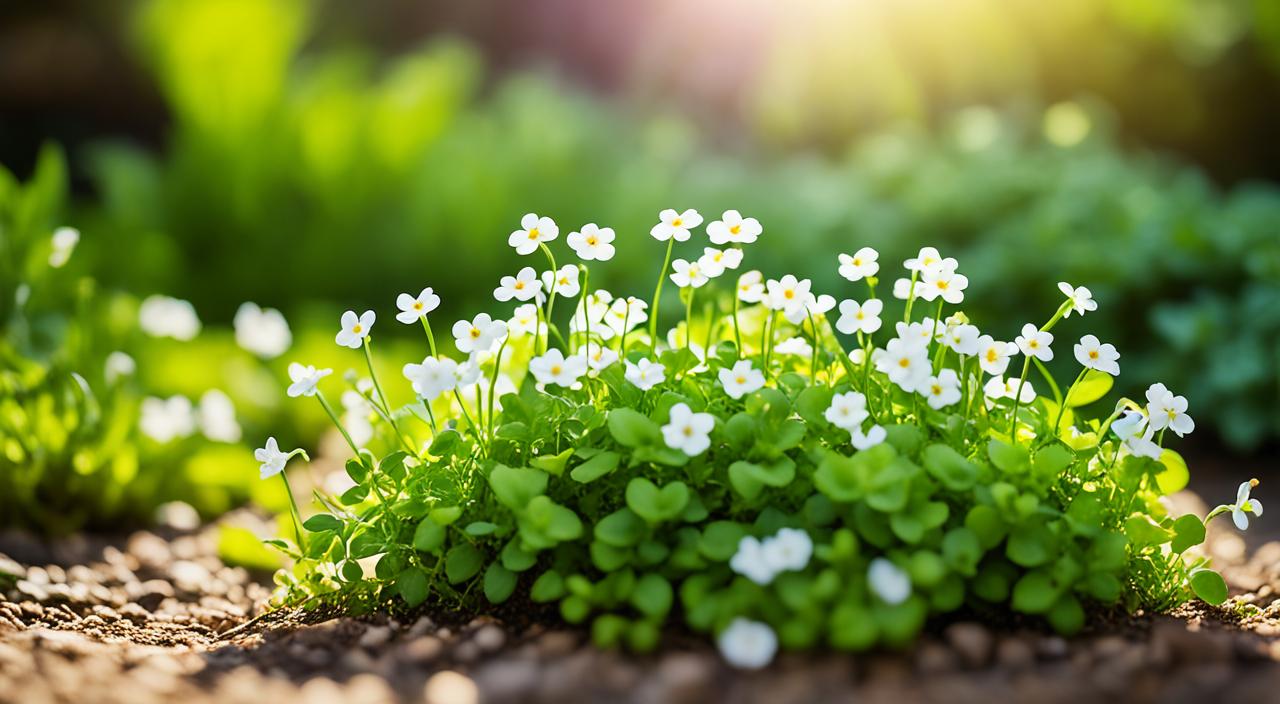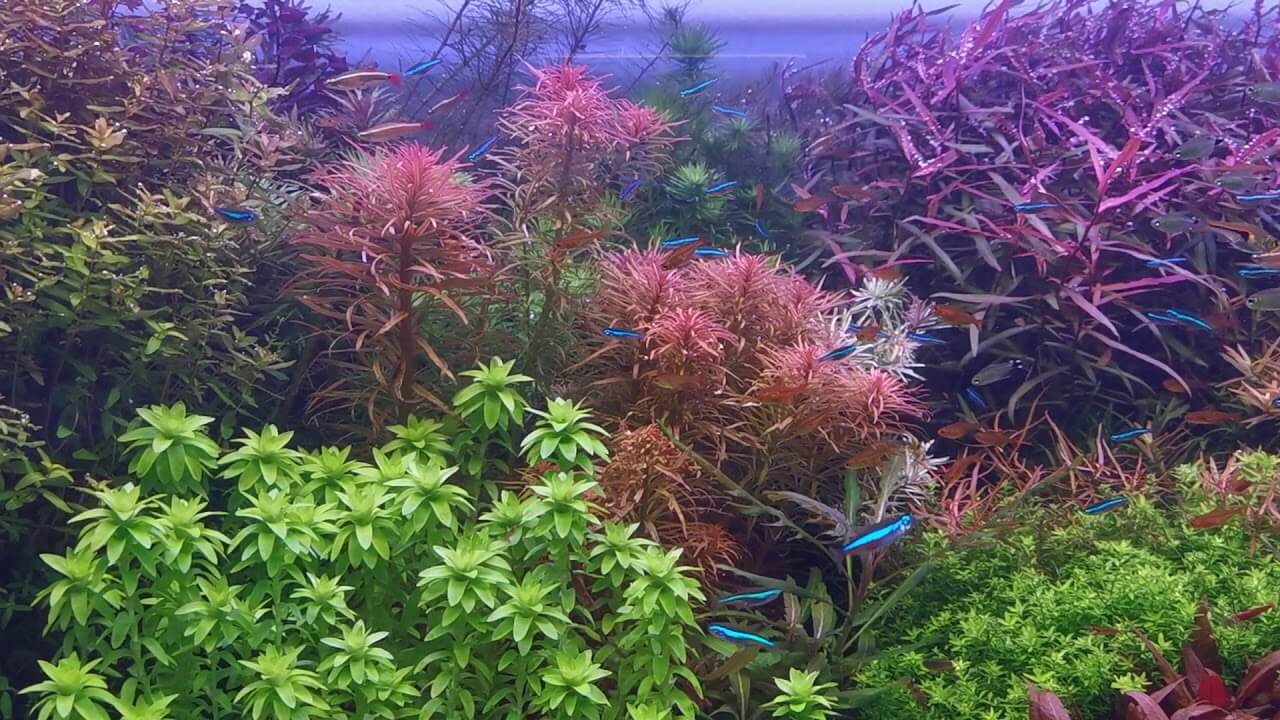Welcome to my comprehensive guide on Cuba Pearl Grass, Hemianthus micranthemoides. This popular freshwater aquarium plant is highly sought after for its ability to create lush, green carpets in aquascapes. Whether you’re an experienced aquarist or just starting, learning about the care, aquascaping potential, and maintenance of Cuba Pearl Grass will help you create a stunning aquatic masterpiece.
Key Takeaways:
- Hemianthus micranthemoides, commonly known as Cuba Pearl Grass, is a popular aquatic plant prized for creating dense, carpet-like growth in freshwater aquariums.
- This plant requires high lighting levels and CO2 supplementation to thrive, making it ideal for experienced aquascapers looking to create vibrant, visually striking displays.
- Cuba Pearl Grass is native to Cuba and grows in marshy areas and along the edges of streams and rivers.
- Proper placement and lighting are crucial for the successful growth of Hemianthus micranthemoides, with the foreground or midground optimal positions in the aquarium.
- When selecting tank mates, opt for small, peaceful fish, shrimp, and snails that won’t disturb or eat the delicate foliage of Cuba Pearl Grass.
Brief Overview Of Cuba Pearl Grass (Hemianthus micranthemoides)
Cuba Pearl Grass, also known as Hemianthus micranthemoides, is a popular choice for aquascaping due to its small size and ability to form dense carpets. This high-light aquarium plant adds a vibrant green touch to any aquarium, creating an eye-catching focal point. Ensuring the optimal growth and development of Cuba Pearl Grass requires high lighting levels and CO2 supplementation. These requirements allow the plant to thrive and maintain its vibrant colouration.
Propagation of Cuba Pearl Grass can be done through cutting and replanting stems or through tissue culture. Both methods are effective in establishing new growth and expanding the carpeting effect of the plant in the aquarium. Hemianthus micranthemoides can create a stunning underwater landscape with proper care and maintenance.
Cuba Pearl Grass (Hemianthus micranthemoides) Information Table:
| Characteristics | Description |
|---|---|
| Scientific Name: | Hemianthus micranthemoides |
| Common Names: | Cuba Pearl Grass, Pearl Weed, Baby Tears |
| Origin: | North America |
| Height: | 2-10 cm |
| Growth Rate: | Moderate to Fast |
| Colour: | Bright Green |
| Aquarium Placement: | Foreground to Midground |
| Water Type: | Freshwater |
| pH: | 5.0 – 7.5 |
| Care Level: | Moderate |
| Light Requirements: | High (50-70 PAR), 5000-7000 Kelvin for optimal color and growth, 40-60 LUX for healthy development |
| CO2 Requirements: | Recommended for optimal growth |
| Temperature: | 20°C – 28°C (68°F – 82°F) |
| Flow Rate: | Moderate (benefits from some water movement but not strong currents) |
| Propagation: | Cuttings (stems can be replanted in the substrate to propagate) |
| Feed Type: | Benefits from liquid fertilizers and CO2 supplementation, especially in high-light conditions |
The light requirements for Cuba Pearl Grass are pretty specific to ensure vibrant growth and colouration. A high light intensity (50-70 PAR) is ideal, with a colour temperature of 5000-7000 Kelvin to mimic natural daylight and promote photosynthesis. LUX levels should be maintained around 40-60 for healthy plant development. Proper lighting, coupled with CO2 supplementation and nutrient-rich substrate, will help maintain this plant’s lush, carpet-like appearance.
Origins And Habitat
Hemianthus micranthemoides, commonly known as Cuba Pearl Grass, originates from Cuba and is native to marshy areas and the edges of streams and rivers. This plant is well-adapted to a tropical environment and thrives in warm temperatures. It can also be found in other parts of Central and South America.
Understanding the natural habitat of Hemianthus micranthemoides is crucial for replicating optimal conditions in aquariums. Aquarists can create an ideal home for this beautiful aquatic plant by providing similar environmental factors.
To visualize the origins and habitat of Cuba Pearl Grass, take a look at the image below:
| Cuba Pearl Grass (Hemianthus micranthemoides) Origins | Cuba Pearl Grass (Hemianthus micranthemoides) Habitat |
|---|---|
| Cuba | Marshy areas |
| Central and South America | Edges of streams and rivers |
Morphological Characteristics
Cuba Pearl Grass, scientifically known as Hemianthus micranthemoides, exhibits distinct morphological characteristics, making it a popular choice among aquarists. Its small, round leaves closely resemble tears, earning it the nickname “dwarf baby tears.” These bright green leaves grow in dense clusters, creating a striking carpet-like effect in the aquarium. The plant’s delicate, thin stems spread horizontally, forming a thick mat that adds depth and texture to the aquatic landscape.
The unique morphology of Hemianthus micranthemoides enhances the visual appeal of any aquascape, providing a lush and vibrant aesthetic. The dense clusters of tear-shaped leaves create a captivating backdrop for other aquatic plants and ornamental fish. Additionally, the thick mat formed by the plants’ spread-out stems creates a welcoming environment for small marine creatures, offering a place to hide and seek refuge.
Placement And Lighting
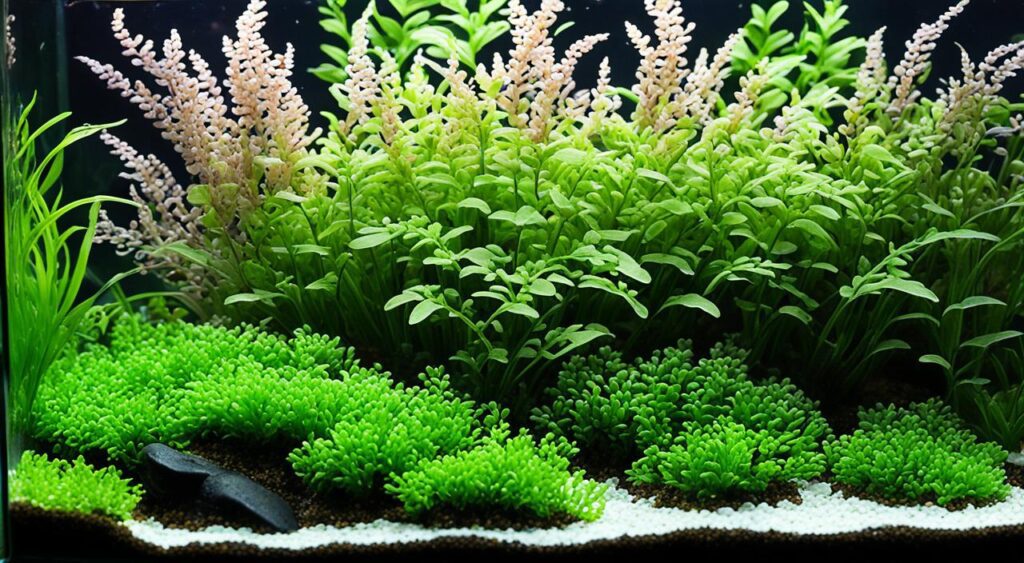
Proper placement and lighting are crucial for the successful growth of Cuba Pearl Grass. It is a high-light plant that requires intense illumination to thrive. Placing it in the foreground or midground of the aquarium allows the plant to receive adequate light.
When considering the placement of Hemianthus micranthemoides, it is essential to ensure that it is not overshadowed by taller plants or decorations that may block the light. Adequate light penetration is necessary for the proper photosynthesis and growth of the plant.
Regarding lighting requirements, providing a solid light source, such as an aquarium LED light, will help create the ideal conditions for Cuba Pearl Grass. A light spectrum in the range of 6,500K to 8,000K is recommended to maintain the vibrant green colouration of the plant.
Monitoring the light intensity and duration is crucial to prevent excessive algae growth, which can compete with Hemianthus micranthemoides for nutrients and light. Using a timer to provide consistent lighting for 10-12 hours daily is a good practice.
In summary, placing Cuba Pearl Grass in a suitable location within the aquarium and providing it with intense illumination will promote its healthy growth and vibrant appearance.
What Are Good Tank Mates?
Good Tank Mates
Cuba Pearl Grass, also known as Hemianthus micranthemoides, can thrive alongside various compatible aquatic species in an aquarium. When choosing tank mates for Hemianthus micranthemoides, it’s important to consider species that are small, peaceful, and won’t disturb or consume the delicate foliage of the plant. Some good tank mates for Cuba Pearl Grass include:
- Neon Tetras
- Cherry Shrimp
- Mystery Snails
These species are known for their peaceful behaviour and smaller size, making them suitable companions for Hemianthus micranthemoides. They can coexist harmoniously, creating a vibrant and balanced aquatic environment.
Fish Species To Avoid
While many aquatic species can coexist with Cuba Pearl Grass, some fish species should be avoided to ensure the plant’s well-being. These species may threaten Hemianthus micranthemoides due to their aggressive behaviour or tendency to uproot plants. It is best to avoid the following fish species as tank mates for Cuba Pearl Grass:
- Tiger Barbs
- Goldfish
- Red-tailed Sharks
These fish species are known for their nipping or digging behaviours, which can damage or uproot Cuba’s Pearl Grass. Aquarists can maintain a thriving and visually appealing Hemianthus micranthemoides carpet in their aquarium by avoiding these species.
Feeding (Fertilization)
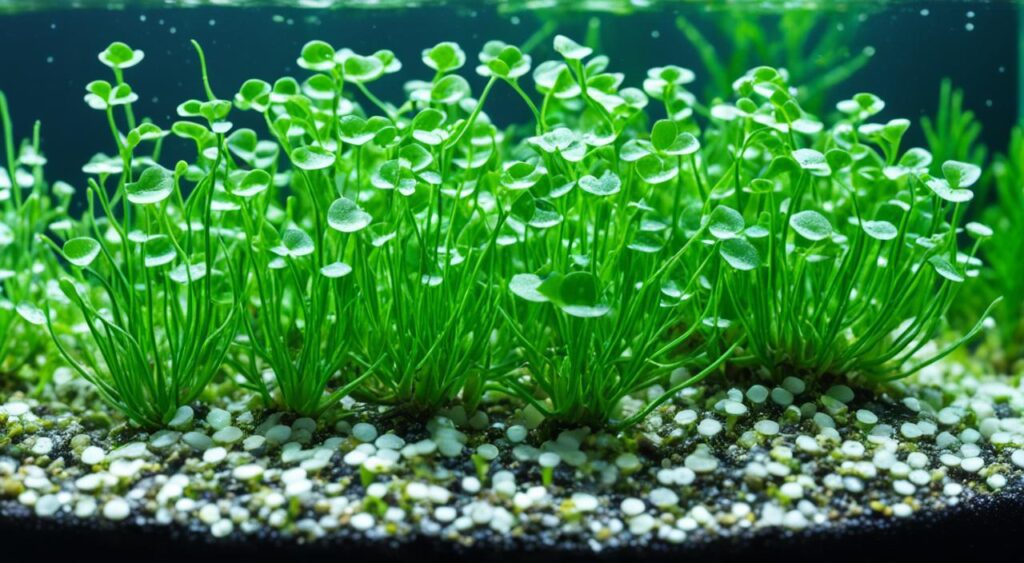
How Much And How Often To Feed
Proper feeding and fertilization are crucial for the healthy growth of Hemianthus micranthemoides, commonly known as Cuba Pearl Grass. By providing the plant with essential nutrients, vibrant colouration and lush carpeting can be maintained. Finding the right balance of feeding and fertilization is vital to ensure optimal growth.
Hemianthus micranthemoides typically benefit from a nutrient-rich substrate. However, additional supplementation may be necessary to meet its nutritional needs completely.
When feeding Cuba Pearl Grass, a balanced liquid fertilizer formulated for aquatic plants can be used. Such fertilizers provide the necessary macro- and micronutrients essential for healthy plant growth. Following the manufacturer’s instructions and dosage recommendations is vital to avoid over-fertilization, which can lead to algae growth and other complications.
A general guideline for feeding Hemianthus micranthemoides is to add liquid fertilizer once or twice a week. The exact frequency and amount may vary depending on the tank’s size, lighting, and the presence of other plants or livestock. Monitoring the plant’s growth and observing any signs of nutrient deficiencies, such as yellowing or stunted growth, can help determine if adjustments to the feeding regimen are needed.
CO2 Injection
CO2 injection is crucial for cultivating Hemianthus micranthemoides, commonly known as Cuba Pearl Grass. This plant has a high demand for carbon dioxide to support its rapid growth and vibrant appearance. Adequate CO2 supplementation ensures that the plant has access to the necessary carbon source for photosynthesis and overall health.
Different methods of CO2 supplementation can be utilized in the aquarium to meet the needs of Hemianthus micranthemoides. These methods include:
- Pressurized CO2 systems involve using a CO2 cylinder, regulator, and diffuser to deliver controlled amounts of carbon dioxide into the aquarium water. Pressurized CO2 systems are highly effective in providing stable and consistent CO2 levels.
- DIY CO2 systems: DIY (Do-It-Yourself) CO2 systems can be created using simple household items such as yeast, sugar, and a homemade reactor. Although less expensive than pressurized systems, DIY CO2 systems may have fluctuating CO2 levels and require more frequent maintenance.
- Liquid carbon supplements: Liquid carbon supplements, such as glutaraldehyde-based products, can be used as an alternative to CO2 injection. These supplements provide a source of carbon that is readily available to the plants. However, they are not as effective as CO2 injection and may not stimulate growth to the same extent.
The choice of CO2 supplementation method will depend on factors such as budget, tank size, and the level of control desired. It is crucial to monitor CO2 levels regularly and adjust the dosage based on the plant’s needs and the aquarium ecosystem’s overall health.
Care
Planted Tank Parameters
Creating and maintaining the ideal parameters in a planted tank is crucial for the health and growth of Hemianthus micranthemoides. Here are some key factors to consider:
- Lighting: Provide high-intensity lighting to support photosynthesis and encourage lush growth. LED or fluorescent lights with a colour temperature of around 6500K are recommended.
- Temperature: Maintain a temperature range of 72-78°F (22-26°C) to replicate the plant’s natural tropical habitat.
- pH Level: Aim for a slightly acidic to neutral pH between 5.5 and 7.5.
- Carbon Dioxide: To enhance growth, consider supplementing with carbon dioxide (CO2). CO2 injection systems or liquid carbon additives can be used.
- Substrate: Choose a nutrient-rich substrate, such as aqua soil or nutrient-rich sand, to provide essential nutrients for the plant’s roots.
Water Quality
Ensuring optimal water quality is essential for the well-being of Hemianthus micranthemoides. Here are some key considerations:
- Ammonia and Nitrite: Maintain low levels of ammonia and nitrite to prevent harm to the plant. Regular water testing and proper filtration are key.
- Nitrate: Keep nitrate levels below 20 ppm through regular water changes, as high nitrate levels can inhibit the plant’s growth.
- Hardness: Aim for a moderate hardness level, around 2-6 dKH, to provide the plant with essential minerals without causing excessive hardness-related issues.
Filtration
Choosing the right filtration system is crucial for maintaining water quality and ensuring the health of Hemianthus micranthemoides. Here are some considerations:
- Mechanical Filtration: Utilize a filter with mechanical media to remove debris and prevent substrate clogging.
- Biological Filtration: Incorporate a biological filter to establish beneficial bacteria colonies that help break down waste and maintain water quality.
- Chemical Filtration: Consider using chemical filtration media, such as activated carbon, to remove impurities and maintain water clarity.
Flow
Proper water flow is essential for maintaining optimal conditions for Hemianthus micranthemoides. Here’s what you need to know:
- Circulation: Ensure good water circulation to prevent stagnant areas that can lead to the accumulation of debris and poor oxygenation.
- Adjusting Flow: Use a filter with adjustable flow settings to create gentle water movement that doesn’t uproot or damage the delicate Hemianthus micranthemoides foliage.
Aquarium Maintenance
Proper aquarium maintenance is essential to ensure the thriving growth of your Cuba Pearl Grass (Hemianthus micranthemoides). This section will explore the critical aspects of maintaining a healthy aquarium environment for your Hemianthus micranthemoides carpet.
Testing Water Conditions
Regularly testing the water conditions in your aquarium is crucial to promote optimal growth and health. This will allow you to monitor pH, ammonia, nitrite, and nitrate levels. Hemianthus micranthemoides thrives in a slightly acidic to neutral pH range of 6.0-7.0. Additionally, it prefers low to moderate lighting levels and requires a temperature range of 72-82°F (22-28°C).
Regular water testing and maintenance will help you identify any imbalances or fluctuations in these parameters, allowing you to take corrective measures promptly. Additionally, it is essential to ensure proper filtration and regular water changes to maintain water quality for the health of your Cuba Pearl Grass.
How To Set Up Your Aquarium Tank
Setting up your aquarium tank correctly is crucial for the success of your Cuba Pearl Grass carpet. Start by thoroughly cleaning the tank and adding a substrate suitable for Hemianthus micranthemoides, such as fine gravel or aquasoil. Next, carefully arrange any hardscape elements, such as rocks or driftwood, ensuring they do not block the light or impede the growth of the carpet.
Once the hardscape is in place, fill the tank with dechlorinated water and set up the filtration system and other equipment. Before adding your Hemianthus micranthemoides, allow the tank to cycle for a few weeks to establish a stable and healthy environment. Cycling involves the growth of beneficial bacteria that will help convert harmful substances like ammonia into less toxic compounds.
Propagation Methods
The carpeting effect of Hemianthus micranthemoides in your aquarium can be expanded through various propagation methods. The most common method is by taking stem cuttings from healthy plants and replanting them in the substrate. Ensure that each cutting has sufficient leaves and stems for successful growth.
Another method is through tissue culture, where small portions of the plant are grown in a specialized laboratory environment and then transferred to the aquarium. This method can be helpful in quickly establishing a dense carpet.
Health And Disease
Maintaining the health of Hemianthus micranthemoides, also known as Cuba Pearl Grass, is crucial for its successful growth in your aquarium. Vigilance and attention to signs of distress or disease are essential. In this section, I will discuss the signs of good health to look out for, as well as indications of poor health. Additionally, I will address common health issues that Hemianthus micranthemoides may encounter, along with treatment options. I will also provide information on plant pests that can affect the vitality of this aquatic plant.
Signs Of Good Health
When Hemianthus micranthemoides is in good health, visible signs indicate its vitality. These signs include:
- The rich green colouration of the leaves
- Active and robust growth
- Lush and dense carpeting effect
- No presence of wilting, yellowing, or browning of the leaves
Regularly monitoring these signs of good health can help ensure that your Cuba Pearl Grass is thriving in your aquarium.
Signs Of Poor Health
If your Hemianthus micranthemoides is experiencing poor health, there are sure signs that you should be aware of. These signs may indicate potential issues and require prompt attention. Signs of poor health in Cuba Pearl Grass include:
- Yellowed or browned leaves
- Slow or stunted growth
- Thinning carpet or patches of bare substrate
- Wilting or drooping leaves
- Presence of algae growth on the leaves
If you observe any of these signs, it is crucial to investigate and address the underlying cause to prevent further decline in plant health.
Common Health Issues And Treatment
While Hemianthus micranthemoides is a relatively hardy plant, it can still experience specific health issues. Some common health issues that Cuba Pearl Grass may encounter include:
| Health Issue | Treatment |
|---|---|
| Algae overgrowth | Implement proper nutrient balance, lighting management, and regular tank maintenance. Use algae-eating fish or shrimp to help control algae growth. |
| Nutrient deficiencies | Adjust fertilization regimen to provide adequate nutrients. Consider using a comprehensive aquarium plant fertilizer. |
| CO2 deficiency | Ensure proper CO2 supplementation to meet the plant’s demand. Consider using a CO2 injection system or liquid carbon supplement. |
| High or low lighting intensity | Adjust lighting levels to meet the specific requirements of Hemianthus micranthemoides. Use a timer to provide consistent lighting duration. |
By addressing these common health issues promptly and appropriately, you can help restore the health and vigour of your Hemianthus micranthemoides.
Plant Pests
Like any other aquarium plant, Cuba Pearl Grass is susceptible to certain pests that can negatively impact its health. Some common plant pests that may affect Hemianthus micranthemoides include:
- Snails
- Algae-eating fish or shrimp
- Aphids
- Spider mites
Regularly inspecting your aquarium for the presence of these pests and taking appropriate action, such as manual removal or introducing natural predators, can help protect the health of your Hemianthus micranthemoides and maintain its vitality.
Summary
In this comprehensive guide, we have explored the various aspects of Cuba Pearl Grass (Hemianthus micranthemoides). We’ve learned about its origins, natural habitat, and unique morphological characteristics. Understanding this plant’s ideal placement and lighting requirements is crucial for its successful growth in an aquarium. We have also discussed suitable tank mates and the importance of proper feeding and fertilization.
CO2 injection is an essential factor for the vibrant appearance of Cuba Pearl Grass, and we have explored different types of CO2 supplementation to consider. Taking care of this plant involves maintaining optimal planted tank parameters, ensuring good water quality, and providing suitable filtration and flow. Regular aquarium maintenance, including monitoring water conditions and employing proper propagation methods, is necessary to keep the plant healthy.
Lastly, we have highlighted signs of good and poor health in Cuba Pearl Grass, along with common health issues and their treatments. Understanding these aspects will help aquarists identify and address any potential problems. Following the guidelines presented in this article, you can confidently incorporate Hemianthus micranthemoides into your aquascapes and enjoy the stunning, vibrant results this popular aquatic plant can achieve.
FAQ
What is Cuba Pearl Grass?
Cuba Pearl Grass, scientifically known as Hemianthus micranthemoides, is a popular aquatic plant valued for its ability to create lush, green carpets in freshwater aquariums.
How do I care for Hemianthus micranthemoides?
Hemianthus micranthemoides requires high lighting levels and CO2 supplementation to thrive. It can be propagated through cutting and replanting stems or through tissue culture.
Where is Hemianthus micranthemoides native to?
Hemianthus micranthemoides is native to Cuba and can also be found in other parts of Central and South America.
What are the morphological characteristics of Cuba Pearl Grass?
Cuba Pearl Grass has small, round leaves that closely resemble the shape of tears. The leaves are bright green and grow in dense clusters, creating a carpet-like effect in the aquarium.
Where should I place Hemianthus micranthemoides in my aquarium?
Cuba Pearl Grass should be placed in the foreground or midground of the aquarium to receive adequate light.
What are suitable tank mates for Hemianthus micranthemoides?
Good tank mates include small, peaceful fish, shrimp, and snails that won’t disturb or eat the delicate foliage of Cuba Pearl Grass. However, there are certain fish species to avoid as they may pose a threat to the plant.
How often should I feed and fertilize Hemianthus micranthemoides?
Feeding and fertilization of Hemianthus micranthemoides should be done regularly to promote healthy growth. The frequency and amount of feeding will depend on the specific needs of your aquarium and the health of the plant.
Do I need to inject CO2 for Hemianthus micranthemoides?
CO2 injection is often necessary for the successful cultivation of Cuba Pearl Grass as it has a high demand for carbon dioxide to support its rapid growth and vibrant appearance.
How do I properly care for Hemianthus micranthemoides?
Proper care for Hemianthus micranthemoides includes maintaining ideal parameters for a planted tank, ensuring water quality, choosing suitable filtration systems, and ensuring proper water flow in the aquarium.
How do I maintain my aquarium with Cuba Pearl Grass?
Regular aquarium maintenance is necessary to keep Cuba Pearl Grass thriving. This includes testing water conditions, setting up the aquarium for optimal growth, and using propagation methods to expand the carpeting effect of Hemianthus micranthemoides.
What are the common health issues and treatment options for Hemianthus micranthemoides?
Common health issues that Hemianthus micranthemoides may encounter include poor growth, yellowing leaves, or algae overgrowth. Treatment options may include adjusting lighting and nutrient levels, addressing water quality issues, and manually removing algae.
Can you provide a summary of key information about Cuba Pearl Grass?
Cuba Pearl Grass, also known as Hemianthus micranthemoides, is a popular aquatic plant valued for its ability to create lush, green carpets in freshwater aquariums. It requires high lighting levels, CO2 supplementation, and regular care to thrive. Proper placement and lighting, suitable tank mates, feeding and fertilization, CO2 injection, and aquarium maintenance are all important aspects of Hemianthus micranthemoides care. Understanding its origins, habitat, morphological characteristics, and common health issues can help aquarists cultivate and maintain a vibrant aquascape with Cuba Pearl Grass.

